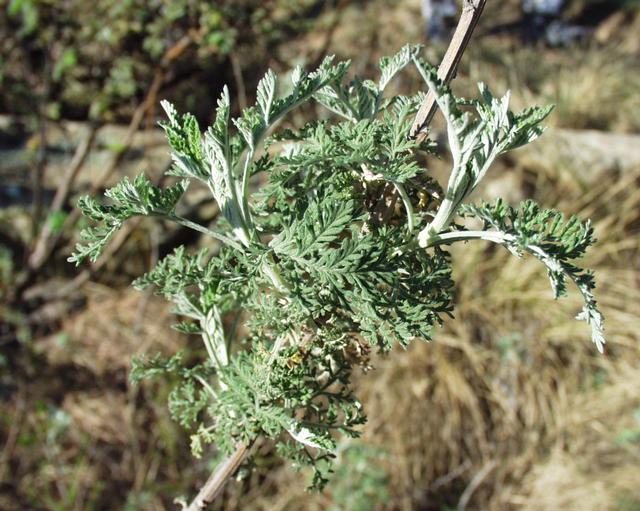
Xavier Argemi first heard the claim that tea made from artemisia herbs could be useful in the treatment of malaria from a TV documentary in 2017.
The documentary, featuring Lucile Cornet-Vernet, the director of the La Maison de l’Artemisia, a non-profit organization that grows artemisia and promotes its use in centers across Africa, focused on the Democratic Republic of the Congo (DRC). The film claimed that for decades major pharmaceutical companies have been profiting from expensive malaria drugs based on artemisinin — the antimalarial for which Tu Youyou won a Nobel Prize in 2015, after distilling it from the Artemisia annua plant — while the tea itself, an ancient Chinese herbal remedy, was just as effective at treating the disease.
His interest piqued, Argemi reached out to Cornet-Vernet, an orthodontist at Paris’ Descartes University. She shared with him the unpublished manuscript of a study — their first large-scale clinical trial — which she said showed that artemisia outperformed a go-to treatment for schistosomiasis, a different parasite-induced disease.
Argemi immediately saw red flags. “I am not a specialist of malaria or schistosomiasis, but when I read the study I was simply totally surprised by the number of inconsistencies at the very first read,” Argemi, of the Clinique Axium in Strasbourg, France, told Retraction Watch by email.
Cornet-Vernet and her team published the study, which involved 800 patients, in 2018. Then in 2019, they published another study of 1,000 patients claiming to show the herbal remedy was effective against malaria, even outperforming artemisinin-based combination therapy drugs (ACTs). Both studies were based on data from different wings of the same joint trial in Kalima, DRC.
Argemi feared La Maison de l’Artemisia’s advocacy and media coverage could affect French national policy on the “miracle” treatment — one that’s now being considered for COVID-19.
“I decided to contact several colleagues to get more deeply into this as the publicity for Artemisia was growing and because I started to have patients with malaria in my hospital after using Artemisia based prophylaxis,” Argemi told Retraction Watch. “So at this time, I felt personally involved, as a practitioner that actually treat[s] people infected with malaria.”
Argemi’s search for answers would eventually lead to a legal threat against artemisia’s critics, as well as uncover allegations of bribery, imprisonment and poisoning by those who didn’t want the study to proceed. A retraction is forthcoming. The controversy comes as advocates hope an herbal tea will make malaria treatment more available in impoverished parts of the world — but the World Health Organisation and French public health agency advise against it.
André Gillibert, a public health doctor at Rouen University Hospital, in France, who has become one of the main critics of the artemisia studies, first wrote to Cornet-Vernet in October 2018 because a colleague of his was helping her with a clinical trial, Gillibert told Retraction Watch. She shared a draft of the schistosomiasis paper with him shortly after.
At that point, she was happy to share information, Cornet-Vernet told us, and was glad to hear about Gillibert’s interest in the study because she knew that he was a qualified statistician.
Gillibert was concerned that La Maison de l’Artemisia, which claims to locally produce artemisia in 23 countries, didn’t have strong enough clinical evidence to recommend the treatments for broad use. Cornet-Vernet became interested in artemisia herself when she learned that a friend of hers traveling in Africa had used it to recover from malaria.
Gillibert’s and Argemi’s paths crossed in a shared email exchange with Cornet-Vernet in early November 2018. Shortly after, Argemi showed him a letter to the editor on the schistosomiasis study which he and other collaborators were working on.
Gillibert contacted Thomas Efferth, the editor of Elsevier’s Phytomedicine, the journal that published the schistosomiasis study, with his concerns. Efferth agreed to let him and collaborators post their comment on the study, provided the authors had a response.
The journal published both the comment and response. Then when a follow up study focusing on malaria came out in December 2019, Gillibert and others quickly wrote a second letter, expressing concerns over many of the same issues they had with the first paper. Efferth again agreed to publish the comment with a response from the authors.
Gillibert decided that before sending out a third critique, he should address the researchers directly and give them a chance to show that they had data to back their results.
The authors’ response confused him more than anything in his earlier investigation.
In early March, 2019, Gillibert asked to see the data for reanalysis and Cornet-Vernet referred him to Pamela Weathers, the last author on the paper, who had the files.

When he made the request, Gillibert doubted the dataset even existed, but to his great surprise, Weathers, a plant biologist at the Worcester Polytechnic Institute in Massachusetts, sent him the datasets for both the malaria and schistosomiasis studies that month.
“I was not so surprised by the content of the database but by the fact that authors (Pamela Weathers) would actually share these databases,” Gillibert told Retraction Watch in an email.
What astounded him was that they would voluntarily share files with what he immediately saw as glaring issues.
He didn’t need to do any math to find that something was wrong with the data — the numbers themselves looked highly improbable. To him, the databases seemed “obviously fraudulent” with evidence of ”copy-paste everywhere,” Gillibert said.
Precise numbers showed up repeatedly for many entries in the same columns for things like patient temperatures and parasite counts. He also noticed that some of the neighboring columns appeared misaligned, resulting in inconsistent patient numbers along the same table rows. Gillibert showed Retraction Watch the data via screen share to support these claims but did not share any data files.
Gillibert said Weathers seemed genuine and forthright in sharing the data, which made him think perhaps she wasn’t aware of how flawed the data were. He had a similar feeling after his communications with Cornet-Vernet.
After seeing the data firsthand, Gillibert became convinced that the studies should be retracted. In July 2019, he and his colleagues submitted a third letter calling for the retraction of both studies due to the issues with the data.
Two months later the editor of Phytomedicine emailed Gillibert, asking him and other commenters to compile a thorough supporting manuscript containing all the evidence supporting their conclusions in the next month. He rushed to complete the 71-page document before the October 20 deadline but before he could submit it he would have another surprise, this time one that sent his stress level through the roof.
On Oct. 6, 2019, Gillibert received a pointed but confusing email from Jerome Munyangi, the lead author of both studies, who claimed that Gillibert had made the raw data available publicly without permission.
“I do not know who authorized the transmission of this database,” Munyangi wrote, “but you are aware that this conduct is absolutely unscientific and unethical. Needless to say, I myself did not know that raw data was being made available via the internet. Pamela Weathers and Lucile Cornet told me that they did not pass this data on to the [journal].”
Weathers described Munyangi at this time as angry and deeply offended that there was any doubt surrounding the integrity of his work. (Munyangi has not responded to requests for comment from Retraction Watch.)
A few days later, Gillibert received a “mis en demeure” (a formal notice) from a lawyer saying he had violated the author’s copyright on the data by publishing it. The problem? He had posted the files to Elsevier’s manuscript submission system to support his team’s third letter to the editor in July, 2019.
“We gave him everything,” Cornet-Vernet wrote in an email. “And in September 2019, we were so surprised to see our data on the Elsevier website. It was done by Dr Gillibert without our consent. So I’ve asked my lawyer [to] have Elsevier pull the data.”
Gillibert pointed out, however, that without the unique access link associated with the file, no one else would be able to view it as the system is not public.“[I]t simply was not true but it gave an argument to retract the letter we just wrote,” Argemi said of the legal threat. “Very strange.”
Gillibert wanted to avoid legal risk, despite feeling he would most likely be protected under French whistleblower laws, “So at the time to protect myself, I immediately asked to remove the file on Elsevier’s platform,” he said.
Nothing like this had ever happened to Gillibert before. Only “Two or three hours elapsed between the time I opened the letter containing the formal notice and the time I sent back a letter showing all that I had done to attempt to delete the files,” he told Retraction Watch.
Cornet-Vernet said she’s not a researcher and relied on co-authors such as Weathers, Munyangi, and Christian Perronne, a prominent physician and infectious disease specialist at the Assistance Hôpitaux Publique de Paris in France, to interpret the situation. “They just told me ‘Oh, the data are on the net. They are not allowed to do that. It’s incredible,’” Cornet-Vernet said.
The dataset shared with the editor wasn’t complete, however. “They forgot one file,” Cornet-Vernet said. “And so we were … quite upset, quite angry.” She wondered if the file was left out deliberately to make the dataset look worse.
Would she have sued Gillibert if he didn’t remove the dataset?
“No, no, absolutely not,” Cornet-Vernet said. If they hadn’t taken down the dataset, she said, she would have just called him to ask about it.
Then the exchange in the journal disappeared.
The group first noticed sometime in October that their comment on the schistosomiasis study and the response to it had been temporarily removed. Then mid-November, they noticed the same thing had happened to the comment and response on the malaria study.
The next month, Argemi wrote to Gillibert that the schistosomiasis letters were restored. As of the time of this writing, the comment and response on the malaria study are still temporarily withdrawn.
Efferth, the journal’s editor, told Gillibert that he was arranging an external review of the articles.
He referred our request for comment to Andrew Davis, the communications director for Elsevier, who said the two papers by Munyangi and colleagues will be retracted next week and that the letter to the editor would be reinstated.
The notice will read, in part: “This article has been retracted at the request of the Editor-in-Chief. Concerns have been raised about the timely approval of the Ethics Committee for the study presented by this article, the consent of the trial participants to publish their data as well as the reliability of the data included in the article.”
“The authors were not able to provide reasonable explanations and the Editor-in-Chief decided to retract the article.”
For many researchers a retraction might be the worst moment in the arc of a study. But not in this case.
First, the medical director for the Kalima Health Zone, where the trial took place, created roadblocks. At one point, according to Cornet-Vernet, he demanded personal payment for the trial to proceed. The researchers relented, and Cornet-Vernet said she suspects that the medical director had a corrupting influence on the results. She said she thinks it’s likely that the data were either deliberately sabotaged at the medical director’s request, or negligently reported by the staff members working under him.
Then Munyagi’s laptop — which held the experimental data — was stolen, according to Weathers, who said Munyagi had to recover the data from hardcopy notebooks.
Munyagi also blamed local pharmaceutical distributors for the trial’s troubles. Many locals have started using artemisia teas to treat their malaria instead of purchasing significantly more expensive ACTs, according to the authors. Because of this, they say, local pharmaceutical distributors have lost considerable revenue because of his work.
Munyangi said in the 2017 documentary that he believes they tried to poison him. He became gravely ill partway through the trial and had to be air transported to a distant hospital with adequate treatment facilities, Cornet-Vernet said.
After he was hospitalized, Cornet-Vernet said, another author, Michel Idumbo of the Centre de Santé de Lubile in Maniema, DRC, took over directing the trial, despite the lack of any experience performing clinical trials.
And after that, according to Weathers, Munyangi was arrested by the Congolese government. Cornet-Vernet said he was held captive and tortured, but eventually released and granted asylum in France.
Munyangi has received heavy media attention for his artemisia trials, including the France TV investigation Argemi saw. Munyangi is now considering a trial testing artemisia as a COVID-19 treatment.
“[A]fter all he’s been through, I don’t believe a man is lying,” Weathers said of Munyangi.
Weathers chalks up the data issues to the limited resources available to those working on the ground. She defended the authenticity of the data and described an old WHO parasite counting method which involves rounding to orders of magnitude.
Weathers said, “[S]o a lot of data, especially near the end of the study had a lot of those — what looks like just copied over data … And that’s how they pasted it in which is not great, but it was a little too late for me to do much about it.”
The WHO protocols Weathers referred to, called the “Plus method,” are described in a 2010 WHO malaria booklet. The WHO says the strategy entails using plus signs to indicate parasite count magnitudes, but did not, even in 2010, advise using the method due to its limitations.

Florian Naudet, a psychiatrist and meta-researcher at the University of Rennes 1 in France has been speaking to Gillibert about the trials and seen the datasets, wrote about problems he noticed in the artemisia trials in a series of tweets. He pointed out to us in email that all the parasite data he and Gillibert saw were given as quantitative values, not plus signs. He also argues that the rounding to orders of magnitude values would not be enough to explain the data’s anomalies.
Cornet-Vernet said that both Lu Chen, a math graduate student who performed the statistical analysis and an independent statistician in Lubumbashi, DRC, found that the data issues were not significant enough to affect their findings. Weathers said she was confident in these analyses.
If the group knew the data were likely compromised, should they have published the results?
“I don’t know,” Cornet-Vernet said. “In fact, the thing is I was very confident in Pamela Weathers and … her staff and even Christian Perronne and all the other professors in Kinshasa, and they all say, ‘okay, it’s not perfect, but it’s very interesting.’ And I trust that. And because nobody had, had done what we did, and they wanted a sort of breakthrough in this…we did something never done before and and everyone, everyone wanted it published. So, it was done.”
Still, Weathers and Cornet-Vernet agree that the study data could have a lot been better.
“I’m sure it’s not a good design,” Cornet-Vernet told Retraction Watch. “But at this time, we did [it] like that because it was so simple to do [it] like that.”
Feelings are still raw. Cornet-Vernet claims that the critics of the artemisia studies have it out for one of the authors, Christian Perronne, over the raging debate on whether chronic Lyme disease exists. Gillibert said that the commenters have diverse opinions and while some members do disagree with Perronne on Lyme, he and Naudet are not involved in the field and have no stake in it. He also pointed out that Perronne’s role in the study appears minor based on the contributions section.
Argemi said that he does disagree with Perrone on Lyme disease, but added that Perronne happened to be on the medical panel which reviewed him before he was awarded his associate professorship. Perronne was an objective and fair reviewer in his experience. Argemi said he has no issue with him.
(Perronne dismissed all concerns posed about the study and a reference to the recent withdrawal of a preprint on COVID-19 he’d posted as “fake news” in an email to Retraction Watch.)
“I do not think that our comments are biased against artemisia,” Gillibert told us. “Especially because they concentrate on scientific arguments.”
Gillibert added, “Indeed, my lengthy experience with this story lead me to being suspicious of anything related to artemisia or Phytomedicine. It also reduced my trust in peer-reviewing in general, raised my level of critical reading of all articles.”
Weathers and Cornet-Vernet maintain that the resources available to researchers in the DRC are not equivalent to those in Western countries, and that should be taken into account when evaluating the research.
But Gillibert says that’s not an excuse for publishing seriously flawed work: “Whether the databases were fabricated, falsified or corrupted by accident does not matter much since the consequences are the same: erroneous results and misleading conclusions.”
Like Retraction Watch? You can make a tax-deductible contribution to support our work, follow us on Twitter, like us on Facebook, add us to your RSS reader, or subscribe to our daily digest. If you find a retraction that’s not in our database, you can let us know here. For comments or feedback, email us at [email protected].